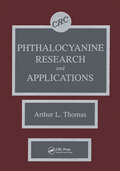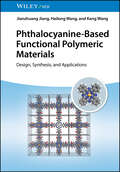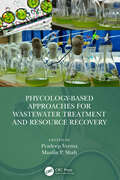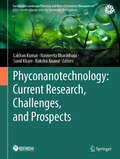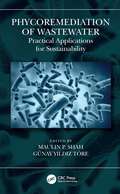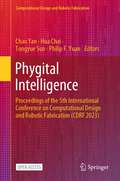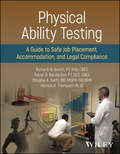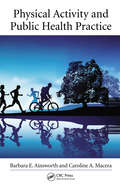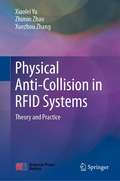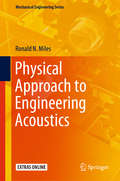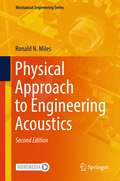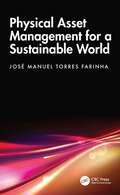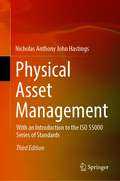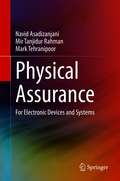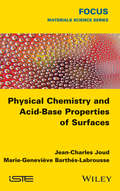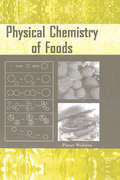- Table View
- List View
Phthalocyanine Research and Applications
by Arthur L. ThomasThe purpose of this monograph is to provide a summary for those who are active in the field of phthalocyanine research. This volume allows the reader to quickly-and at a reasonable cost-determine what is being accomplished so that he may plan his own research programs. It covers such topics as synthesis, reactions, inks, energy systems, coatings, toners, and electrophotographic plates and developers, just to name a few. Packed with over 40 structural drawings of phthalocyanine molecules, this one-of-a-kind reference provides the necessary description and visualization to stimulate further research. This work is an indispensable resource for researchers and practitioners, both novice and experienced, in the field of phthalocyanine science and technology.
Phthalocyanine-Based Functional Polymeric Materials: Design, Synthesis, and Applications
by Jianzhuang Jiang Hailong Wang Kang WangA carefully curated collection of resources covering the concepts, perspectives, and applications of phthalocyanine chemistry In Phthalocyanine-Based Functional Polymeric Materials: Design, Synthesis, and Applications, a team of distinguished researchers delivers a comprehensive discussion of phthalocyanine-involving hybrids, molecular cages, coordination polymers, covalent organic frameworks, and organic polymers. The book also explains a diverse array of the applications of these novel materials in chemical sensors, organic catalysts, electrocatalysis, photocatalysis, energy storage, and more. The authors have included material designed to help you improve the design of monomers to synthesize polymers with desired functionalities. A valuable reference in the development of phthalocyanine chemistry, readers will also find: A thorough introduction to phthalocyanine-based polymers and their uses in sensors, catalysis, energy storage, and other applications Comprehensive explorations of the extended molecular systems of phthalocyanines, filling the gap between monomeric phthalocyanine compounds and polymers Practical discussions of a variety of phthalocyanine-based polymer systems, their potential applications, and major design and synthesis challenges Complete treatments of these novel materials appropriate for readers in academia and industry Perfect for polymer, organic, inorganic, catalytic, complex, and structural chemists, Phthalocyanine-Based Functional Polymeric Materials will also benefit materials scientists and chemists working in industry.
Phycology-Based Approaches for Wastewater Treatment and Resource Recovery
by Maulin P. Shah Pradeep VermaAlgal and phycology-based approaches for wastewater treatment have recently gained interest. Phycology-Based Approaches for Wastewater Treatment and Resource Recovery highlights advanced algal-based technologies developed or being considered for wastewater treatment along with the opportunities that existing technologies can provide at an industrial scale. It covers recent findings on algal-based approaches for the removal of heavy metals, organic pollutants, and other toxicities from sewage and industrial effluents and supplies in-depth analysis on technologies such as biosorption and bioaccumulations. Advanced mathematical modeling approaches to understand waste removal and resource recovery from wastewater are illustrated as well. The book: Provides exhaustive information on the use of algae for the simultaneous treatment and resource recovery of wastewater Discusses algae, microalgae, and cyanobacteria applications in detail Presents critical insight into limitations of the prevalent technologies Reviews methodology of advanced technologies Includes illustrations and interesting trivia boxes throughout the book This book is of interest to researchers, graduate students and professionals in phycology, microbiology, bioremediation, environmental sciences, biotechnology, wastewater treatment, resource recovery, and circular economy.
Phyconanotechnology: Current Research, Challenges, and Prospects (Sustainable Landscape Planning and Natural Resources Management)
by Navneeta Bharadvaja Lakhan Kumar Raksha Anand Sunil KhareThis book explores the scientific development in the field of algal-based nanomaterials synthesis, production methods, and commercial and utilization aspects of phyconanomaterials to address a range of problems of humanity. Nanomaterials have been recently explored for and employed in environmental remediation, biomedical applications, agriculture, food industries, energy sectors, cosmetics, biolabeling, and space due to their versatility and wide range of applicability owing to their peculiar material characteristics and other attributes. Their conventional synthesis approaches are replacing green methods as the latter is comparatively economical, energy-efficient, and eco-friendly. Biological entities and derived materials-based nanomaterials synthesis is such a green approach. Using natural systems to synthesize nanomaterials does not leave behind any toxic compounds generally produced as by-products when physical or chemical methods are employed. Phyconanotechnology, a green way of synthesizing nanomaterials, can be used to overcome this issue. In the proposed book, algal diversity-based nanomaterials synthesis and their applications will be presented to the readers.
Phycoremediation Processes in Industrial Wastewater Treatment (Wastewater Treatment and Research)
by Maulin P. ShahIncreasing population and industrialization are the key pollutant contributors in water bodies. The wastes generated by industries are highly hazardous for humans and the ecosystem and require a comprehensive and effective treatment before being discharged into water bodies. Over the years, many up gradations have been introduced in traditional water treatment methods which were expensive and ineffective especially for removal of toxic pollutants. Phycoremediation has been gaining attention due to its mutual benefit in wastewater treatment and for valuable algae biomass production. Wastewater, especially sewage and industrial effluents, is rich in pathogenic organisms, organic and inorganic compounds and heavy metals that adversely affect human and aquatic life. Microalgae use these inorganic compounds and heavy metals for their growth. In addition, they also reduce pathogenic organisms and release oxygen to be used by bacteria for decomposition of organic compounds in a secondary treatment. In this book, the potential of microalgae in wastewater treatment, their benefits, strategies, and challenges are discussed. The increasing need of finding innovative, low-cost, low-energy, sustainable and eco-friendly solutions for wastewater treatment makes the publication of a book on phycoremediation timely and appropriate. Features: (1) Deals with the most emerging aspects of algal research with special reference to phycoremediation. (2) Studies in depth diversity, mutations, genomics and metagenomics study (3) An eco-physiology, culturing, microalgae for food and feed, biofuel production, harvesting of microalgae, separation and purification of biochemicals.
Phycoremediation of Wastewater: Practical Applications for Sustainability
by Maulin P. Shah Günay Yıldız TörePhycoremediation is an alternative method of water and wastewater remediation, which includes the use of algae for treatment, and is an environmentally friendly and sustainable technology. More conventional methods of wastewater treatment have been successful in the removal of conventional contaminants from the water; however, these techniques typically require more time and energy than phycoremediation. Phycoremediation of Wastewater: Practical Applications for Sustainability focuses on the latest developments in water remediation as well as the major challenges faced by municipalities implementing large-scale phycoremediation operations. It addresses the latest advancements in the field as well as the future applications and techniques to make water remediation processes more environmentally sustainable. It focuses on the latest developments in phycoremediation and outlines the major challenges in large-scale operation and implementation. It explores the future scope of the remediation techniques to make processes more sustainable going forward.
Phycotoxins: Chemistry and Biochemistry
by Luis M. Botana Amparo AlfonsoPhycotoxins are a diverse group of poisonous substances produced by certain seaweed and algae in marine and fresh waters and are important to the scientific community for many reasons, the most obvious being that they pose food safety issues which requires a large investment to regularly monitor the presence of these compounds in foods. Phycotoxins: Chemistry and Biochemistry, second edition presents the most updated information available on phycotoxins. Major emphases are given to chemistry and biochemistry, while origins, mechanism of action, toxicology, and analytical methodology are also covered. Since the publication of the first edition, there have been major advances in the science of marine and aquatic toxins, as well as advances in toxicology, analytical chemistry and pharmacology. This fully revised and updated edition includes several new chapters, including those on ciguatoxins, pinnatoxin, ichthyotoxins, as well as new chapters on food safety control of marine toxins, climate change and water toxins, and microalgae as a source of nutraceuticals. The book will be of interest to toxicologists, marine, food, and plant scientists, as well as researchers and academics in the areas of food science, medicine, public health, toxicology, pharmacology and marine biology.
Phygital Intelligence: Proceedings of the 5th International Conference on Computational Design and Robotic Fabrication (CDRF 2023) (Computational Design and Robotic Fabrication)
by Philip F. Yuan Chao Yan Hua Chai Tongyue SunThis open access book is a compilation of selected papers from 2023 DigitalFUTURES — The 5nd International Conference on Computational Design and Robotic Fabrication (CDRF 2023). The work focuses on novel techniques for computational design and robotic fabrication. The contents make valuable contributions to academic researchers, designers, and engineers in the industry. As well, readers will encounter new ideas about understanding intelligence in architecture.
Physical Ability Testing: A Guide to Safe Job Placement, Accommodation, and Legal Compliance
by Richard W. Bunch Trevor D. Bardarson Douglas A. Swift Horace A. Thompson IIIA guide to implementing legally compliant physical ability testing (PAT) programs that prevent injuries, optimize performance, and ensure reasonable accommodations In Physical Ability Testing: A Guide to Safe Job Placement, Accommodation, and Legal Compliance, a team of distinguished medical professionals delivers an expert discussion of the fundamentals of creating a PAT program. Explaining the perspectives of the employer, the authors detail the systematic steps in developing and administering legally valid, job-specific PATs and providing proper interactive accommodation reviews for new hires and incumbent employees. The book covers testing policies and procedures that address methods to avoid discrimination and minimize disparate impact on protected classes such as individuals with disabilities, older adults, women (including those who are pregnant), and individuals affected by medical or behavioral health conditions such as substance use disorders or recent surgeries. It also provides critical information on defending test failure determinations based on the “direct threat” and “undue hardship” defenses. Readers will find: A thorough introduction to the validation process best suited for a defensible PAT programComprehensive explorations of PAT programs in a variety of industriesPractical discussions of administering PATs, legal cases covering them, and published scientific literature related to work physiologyComplete treatments of the validation processes used in ensuring PAT programs remain legally defensible This book is perfect for human resource professionals, occupational physicians and nurses, physical therapists, occupational therapists, chiropractors, safety professionals, industrial hygienists, ergonomists, human factors specialists, and risk managers.
Physical Activity and Public Health Practice
by Barbara E. Ainsworth Caroline A. MaceraPhysical activity remains a critical area of research as we consider cost-effective measures for lowering the chronic disease epidemic worldwide. In our increasingly automated society, many adults and children are not active at health-enhancing levels. In Physical Activity and Public Health Practice, a panel of respected researchers summarizes esse
Physical Anti-Collision in RFID Systems: Theory and Practice
by Xiaolei Yu Zhimin Zhao Xuezhou ZhangThis book highlights the innovative applications of electromagnetics, optics, thermodynamics theories in creating methods for physical-layer collision prevention- "physical anti-collision" in radio frequency identification (RFID) systems. Using engineering mathematical methods as the core of detection and control algorithm design, it proposes semi-physical verification and detection techniques to the dynamic performance testing in RFID systems. The book also introduces the methods to build semi-physical hardware platforms using photoelectric sensing technology. The book provides valuable ideas to the applications of Internet of Things (IOT) systems in smart logistics, car networking, food traceability, anti-counterfeiting and other livelihood fields. It is worth reading for all researchers in IOT and optoelectronic engineering related industries.
Physical Approach to Engineering Acoustics (Mechanical Engineering Series)
by Ronald N. MilesThis textbook presents the fundamentals of engineering acoustics and examines in depth concepts within the domain that apply to reducing noise, measuring noise, and designing microphones and loudspeakers. The book particularly emphasizes the physical principles used in designing miniature microphones. These devices are used in billions of electronic products, most visibly, cell phones and hearing aids, and enable countless other applications. Distinct from earlier books on this topic that take the view of the electrical engineer analyzing mechanical systems using electric circuit analogies. This text uses Newtonian mechanics as a more appropriate paradigm for analyzing these mechanical systems and in so doing provides a more direct method of modeling. Written at a level appropriate for upper-division undergraduate courses, and enhanced with end-of-chapter problems and MatLab routines, the book is ideal as a core text for students interested in engineering acoustics in ME, EE, and physics programs, as well as a reference for engineers and technicians working in the huge global industry of miniature microphone design.
Physical Approach to Engineering Acoustics (Mechanical Engineering Series)
by Ronald N. MilesThis updated edition adds new material on the acoustics of mufflers and ducts, including a new analysis on sound propagation in a duct having a cross sectional area that varies in the direction of the duct length. The textbook retains its class-tested fundamentals of engineering acoustics and examination of in-depth concepts within the domains that apply to reducing noise, measuring noise, and designing microphones and loudspeakers. The book particularly emphasizes the physical principles used in designing miniature microphones. These devices are used in billions of electronic products, most visibly, cell phones and hearing aids, and enable countless other applications. Distinct from earlier books on this topic that take the view of the electrical engineer analyzing mechanical systems using electric circuit analogies. This text uses Newtonian mechanics as a more appropriate paradigm for analyzing these mechanical systems and in so doing provides a more direct method of modeling. Written at a level appropriate for upper-division undergraduate and graduate courses, and enhanced with end-of-chapter problems and MatLab routines, the book is ideal as a core text for students interested in engineering acoustics in ME, EE, and physics programs, as well as a reference for engineers and technicians working in the huge global industry of miniature microphone design.
Physical Aspects of Polymer Self-Assembly
by P. R. SundararajanOffering an overview of principles and techniques, this book covers all major categories of self-assembled polymers - properties, processes, and design. Each chapter focuses on morphology, applications, and advanced concepts to illustrate the advantages of polymer self-assembly across industrial and academic research. * Provides an organized, comprehensive overview of polymer self-assembly, its fundamentals, principles, and applications* Includes chapters on block copolymers, amphiphilic polymers, supramolecular polymers, rotaxenes, polymer gels, dendrimers, and small molecules in polymer matrices* Focuses on novel applications, block copolymer assembly to nanotechnology, photonics and metamaterials, molecular machines and artificial muscle, gels that can be applied to polymer science, materials science, and nanotechnology* Examines state-of-the-art concepts, like lithographic patterning and foldaxane* Discusses challenges and future outlook of a popular and emerging field of study
Physical Asset Management
by Nicholas Anthony John HastingsSignificantly extended from the first edition and published in response to the new international standard ISO55000, this book on physical asset management (2nd Ed. ) presents a systematic approach to the management of physical assets from concept to disposal. It introduces the general principles of physical asset management and covers all stages of the asset management process, including initial business appraisal, identification of fixed asset needs, capability gap analysis, financial evaluation, logistic support analysis, life cycle costing, management of in-service assets, maintenance strategy, outsourcing, cost-benefit analysis, disposal and renewal. Physical asset management is the management of fixed assets such as equipment, plant, buildings and infrastructure. Features include: *Suitable for university courses and builds on first edition to provide further analytical material *Aligned with the international asset management standard ISO55000 *Provides a basis for the establishment of physical asset management as a professional discipline *Presents case studies, analytical techniques and numerical examples with solutions Written for practitioners and students in asset management, this textbook provides an essential foundation to the topic. It is suitable for an advanced undergraduate or postgraduate course in asset management, and also offers an ideal reference text for engineers and managers specializing in asset management, reliability, maintenance, logistics or systems engineering.
Physical Asset Management for a Sustainable World
by José Manuel FarinhaThis book describes techniques, tools, and models about engineering maintenance and life cycle models, aimed at the efficient managing of assets. It presents new asset management models, namely the Holistic Diagnostic Model (HDM) and Integrated Asset Management Support Model (IAMSM), including quantitative decision support tools for life cycle management of physical assets. It presents an overview of the life cycle models for replacement through a global model, with emphasis on availability and maintenance costs. Features: Covers important aspects on Physical Asset Management (PAM) and offers a developed perspective on the economic aspects. Presents the relationships among some maintenance Key Performance Indicators (KPI), specifically MTTR, MTBF, Availability, and Reserve equipment. Analyzes models to calculate the influence of relevant variables on the withdrawal time and in the reserve size of the critical assets. Introduces new diagnostic models and Life Cycle decision support models. Includes new models for diagnosing organizations including pertinent case studies. This book is aimed at researchers, professionals, and graduate students in PAM, maintenance management, and industrial engineering.
Physical Asset Management: With an Introduction to the ISO 55000 Series of Standards
by Nicholas Anthony HastingsThis book presents a systematic approach to the management of physical assets from concept to disposal, building upon the previous editions and brought up-to-date with the new international standards ISO55002 and ISO/TS50010. It introduces the general principles of physical asset management and covers all stages of the asset management process, including initial business appraisal, identification of physical asset needs, capability gap analysis, financial evaluation, logistic support analysis, life cycle costing, strategic asset management planning, maintenance strategy, outsourcing, cost-benefit analysis, disposal and renewal. Features include:providing a textbook for asset management courses to university level;relating closely to the ISO55000 international asset management standard series;providing a basis for the establishment of physical asset management as a professional discipline; andpresenting case studies, analytical techniques and numerical examples with solutions. Written for practitioners and students in asset management, this book provides an essential foundation to the topic. It is suitable for an advanced undergraduate or postgraduate course in asset management and also offers an ideal reference text for engineers and managers specializing in asset management, reliability, maintenance, logistics or systems engineering.
Physical Assurance: For Electronic Devices and Systems
by Mark Tehranipoor Navid Asadizanjani Mir Tanjidur RahmanThis book provides readers with a comprehensive introduction to physical inspection-based approaches for electronics security. The authors explain the principles of physical inspection techniques including invasive, non-invasive and semi-invasive approaches and how they can be used for hardware assurance, from IC to PCB level. Coverage includes a wide variety of topics, from failure analysis and imaging, to testing, machine learning and automation, reverse engineering and attacks, and countermeasures.
Physical Characteristics of Early Films as Aids to Identification: New expanded Edition
by Camille Bolt-WellensAny archivists who have held a piece of fi lm in their hands, wondering how to go about identifying it, recognize the true value of fi lm preservationist Harold Brown's work. In 1967 Brown delivered a pioneering lecture on the identification of early films at the annual Congress of the International Federation of Film Archives (FIAF) in East Berlin. Years of working with Britain's National Film Archive collections, and the close examination of thousands of nitrate prints of the silent period, made Brown a leading authority on early fi lm identification, and an unsurpassed model of methodological consciousness in the archival field. In 1990, FIAF published Brown's Physical Characteristics of Early Films as Aids to Identification, an updated version and a continuation of his 1967 lecture. This publication has long been archivists' trusted companion, constituting a concentrated encyclopedia on all the information that can be discovered or verified through aspects of the fi lm other than the actual projected image – such as perforation shapes; embossed and punched marks; stock manufacturers' and producers' edge marks; frame characteristics; title styles; and production serial numbers. It also included essays on key individual production companies of the silent era. Over the last 30 years, this manual – a basic typewritten 100-page volume (including 20 pages of black & white illustrations), with its easily recognizable red cover – has been an invaluable reference for fi lm archivists and scholars. However, as Brown himself acknowledged in the 1990 edition, the manual was far from definitive. Camille Blot-Wellens, the editor of this new, expanded edition of Brown's 1990 book, belongs to the new generation of researchers who have used Physical Characteristics extensively in their work and have gathered considerable new information on the subject. This new edition is the result of a project she initiated in 2014 with FIAF's support. Brown's original text is now augmented with new original research on key fi lm manufacturers and producers by Camille Bolt-Wellens and other leading archivists and researchers in the field. Richly illustrated (the book contains over 900 images, including 125 in full color), this new 336-page edition of Harold Brown's seminal manual will be welcomed by many, and will no doubt become a must-have working tool for many in the fi lm archiving and academic fields.
Physical Chemistry Essentials
by Andreas HofmannThis textbook covers the fundamentals of physical chemistry, explaining the concepts in an accessible way and guiding the readers in a step-by-step manner. The contents are broadly divided into two sections: the classical physico-chemical topics (thermodynamics, kinetics, electrochemistry, transport, and catalysis), and the fabric of matter and its interactions with radiation. Particular care has been taken in the presentation of the algebraic parts of physico-chemical concepts, so that the readers can easily follow the explanations and re-work relevant discussion and derivations with pen and paper. The book is accompanied by a rich mathematical appendix. Each chapter includes a selection of (numerical) exercises and problems, so that students can practice and apply the learned topics. An appendix with solutions allows for controlling the learning success. Carefully prepared illustrative color images make this book a great support for teaching physical chemistry to undergraduate students.This textbook mainly addresses undergraduate students in life sciences, biochemistry or engineering, offering them a comprehensive and comprehensible introduction for their studies of physical chemistry. It will also appeal to undergraduate chemistry students as an accessible introduction for their physical chemistry studies.
Physical Chemistry and Acid-Base Properties of Surfaces
by Jean-Charles Joud Marie-Geneviève Barthés-LabrousseThe first part of this book looks at the consequence of chemical and topological defects existing on real surfaces, which explain the wettability of super hydrophilc and super hydrophobic surfaces. There follows an in-depth analysis of the acido-basicity of surfaces with, as an illustration, different wettability experiments on real materials. The next chapter deals with various techniques enabling the measurement of acido basicity of the surfaces including IR and XPS technics. The last part of the book presents an electrochemical point of view which explains the surface charges of the oxide at contact with water or other electrolyte solutions in the frame of Bronsted acido-basicity concept. Various consequences are deduced from such analyses illustrated by original measurement of the point of zero charge or by understanding the basic principles of the electrowetting experiments.
Physical Chemistry from a Different Angle
by Georg Job Regina RüfflerLearning the basics of physical chemistry with a unique, innovative approach. Georg Job and Regina Rueffler introduce readers to an almost intuitive understanding of the two fundamental concepts, chemical potential and entropy. Avoiding complex mathematics, these concepts are illustrated with the help of numerous demonstration experiments. Using these concepts, the subjects of chemical equilibria, kinetics and electrochemistry are presented at an undergraduate level. The basic quantities and equations necessary for the qualitative and quantitative description of chemical transformations are introduced by using everyday experiences and particularly more than one hundred illustrative experiments, many presented online as videos. These are in turn supplemented by nearly 400 figures, and by learning objectives for each chapter. From a review of the German edition: "This book is the most revolutionary textbook on physical chemistry that has been published in the last few decades. "
Physical Chemistry of Foods (Food Science And Technology Ser.)
by Pieter WalstraExploring the structure and physical and chemical properties of solutions, dispersions, soft solids, fats, and cellular systems, Physical Chemistry of Foods describes the physiochemical principles of the reactions and conversions that occur during the manufacture, handling, and storage of foods. Coverage progresses from aspects of thermodynamics, b
Physical Chemistry of Macromolecules
by Gary PattersonWritten by a chemical physicist specializing in macromolecular physics, this book brings to life the definitive work of celebrated scientists who combined multidisciplinary perspectives to pioneer the field of polymer science. The author relates firsthand the unique environment that fostered the experimental breakthroughs underlying some of today's
Physical Chemistry of Metallurgical Processes
by M. ShamsuddinThis book covers various metallurgical topics, viz. roasting of sulfide minerals, matte smelting, slag, reduction of oxides and reduction smelting, interfacial phenomena, steelmaking, secondary steelmaking, role of halides in extraction of metals, refining, hydrometallurgy and electrometallurgy. Each chapter is illustrated with appropriate examples of applications of the technique in extraction of some common, reactive, rare or refractory metal together with worked out problems explaining the principle of the operation.
